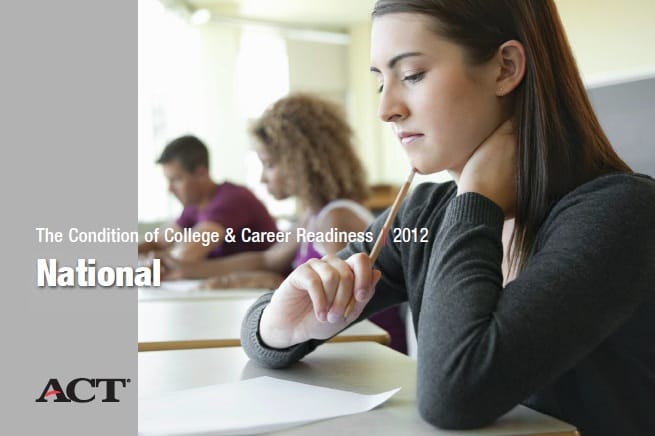 Fifty-four: That’s the percentage of students who took the ACT math exam last spring and failed to meet its benchmark score. (That benchmark signifies that a student attaining it has a 50 percent chance of earning a B, or a 75 percent chance of earning a C, in a credit-bearing college course.) The statistics are a bit better in English (33 percent fell below the ACT benchmark) and reading (48 percent). In science, however, they’re worse: Fully 69 percent of 2012 test-takers failed to meet the ACT benchmark score in this subject. A mere quarter of those who sat for the ACT met the organization’s benchmarks in all four subjects (as has been the case in years prior). Keep in mind, too, that for the most part only kids who plan to attend college even bother with the ACT. Unlike NAEP, in other words, it’s a selective sample of the high school population (and even NAEP omits dropouts). These bleak results—and the uphill battle they portend—are important to keep in mind as the U.S. embarks upon implementation of the Common Core academic standards, which are reportedly aligned with the ACT benchmarks. A very steep slope awaits us.
Fifty-four: That’s the percentage of students who took the ACT math exam last spring and failed to meet its benchmark score. (That benchmark signifies that a student attaining it has a 50 percent chance of earning a B, or a 75 percent chance of earning a C, in a credit-bearing college course.) The statistics are a bit better in English (33 percent fell below the ACT benchmark) and reading (48 percent). In science, however, they’re worse: Fully 69 percent of 2012 test-takers failed to meet the ACT benchmark score in this subject. A mere quarter of those who sat for the ACT met the organization’s benchmarks in all four subjects (as has been the case in years prior). Keep in mind, too, that for the most part only kids who plan to attend college even bother with the ACT. Unlike NAEP, in other words, it’s a selective sample of the high school population (and even NAEP omits dropouts). These bleak results—and the uphill battle they portend—are important to keep in mind as the U.S. embarks upon implementation of the Common Core academic standards, which are reportedly aligned with the ACT benchmarks. A very steep slope awaits us.
SOURCE: ACT, The Condition of College & Career Readiness, (Iowa City, IA: ACT, 2012).
